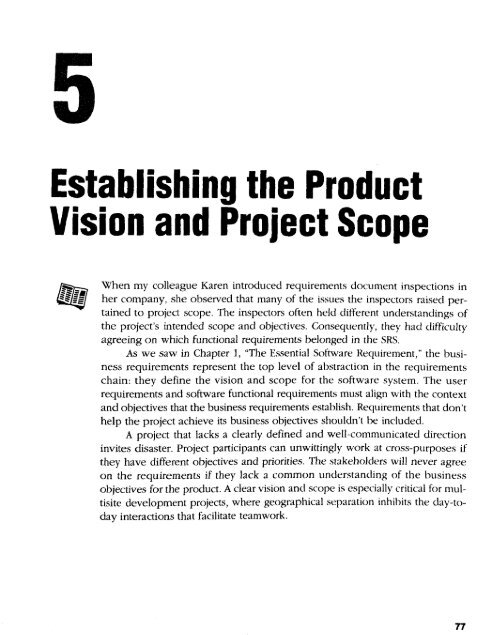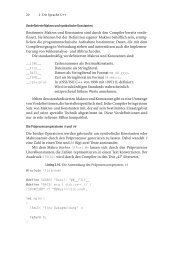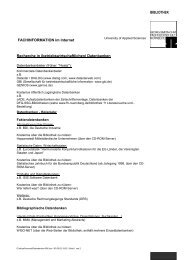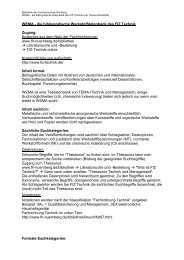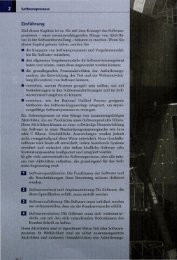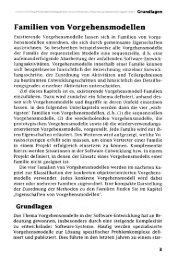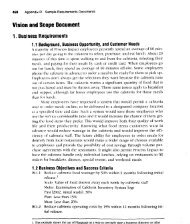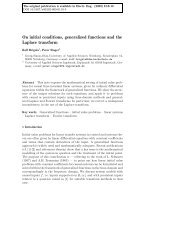Establishing the Product Vision and Project Scope
Establishing the Product Vision and Project Scope
Establishing the Product Vision and Project Scope
Create successful ePaper yourself
Turn your PDF publications into a flip-book with our unique Google optimized e-Paper software.
<strong>Establishing</strong> <strong>the</strong> <strong>Product</strong><br />
<strong>Vision</strong> <strong>and</strong> <strong>Project</strong> <strong>Scope</strong><br />
When my colleague Karen introduced requirements document inspections in<br />
her company, she observed that many of <strong>the</strong> issues <strong>the</strong> inspectors raised pertained<br />
to project scope. The inspectors often helddifferent underst<strong>and</strong>ings of<br />
<strong>the</strong> project's intended scope <strong>and</strong> objectives. Consequently, <strong>the</strong>y had difficulty<br />
agreeing on which functional requirements belonged in <strong>the</strong> SRS.<br />
As we saw in Chapter 1, "The Essential Software Requirement," <strong>the</strong> business<br />
requirements represent <strong>the</strong> top Ievel of abstraction in <strong>the</strong> requirements<br />
chain: <strong>the</strong>y define <strong>the</strong> vision <strong>and</strong> scope for <strong>the</strong> software system. The user<br />
requirements <strong>and</strong> software functional requirements must align with <strong>the</strong> context<br />
<strong>and</strong> objectives that <strong>the</strong> business requirements establish. Requirements that don't<br />
help <strong>the</strong> project achieve its business objectives shouldn't be induded.<br />
A project that Iacks a clearly defined <strong>and</strong> well-communicated direction<br />
invites disaster. <strong>Project</strong> participants can unwittingly work at cross-purposes if<br />
<strong>the</strong>y have different objectives <strong>and</strong> priorities. The Stakeholders will never agree<br />
on <strong>the</strong> requirements if <strong>the</strong>y Iack a common underst<strong>and</strong>ing of <strong>the</strong> business<br />
objectives for <strong>the</strong> product. A dear vision <strong>and</strong> scope is especially critical for multisite<br />
development projects, where geographical separation inhibits <strong>the</strong> day-today<br />
interactions that facilitate teamwork.<br />
n
78 Part II Software Requirements Development<br />
One sign that <strong>the</strong> business requirements are insufficiently defined is that<br />
certain features are initially included, <strong>the</strong>n deleted, <strong>and</strong> <strong>the</strong>n added back in<br />
later. <strong>Vision</strong> <strong>and</strong> scope issues must be resolved before <strong>the</strong> detailed functional<br />
requirements can be fully specified. A statement of <strong>the</strong> project's scope <strong>and</strong><br />
limitations helps greatly with discussions of proposed features <strong>and</strong> target<br />
releases. The vision <strong>and</strong> scope also provide a reference for making decisions<br />
about proposed requirement changes <strong>and</strong> enhancements. Same companies<br />
print <strong>the</strong> vision <strong>and</strong> scope highlights on a poster board that's brought to every<br />
project meeting so that <strong>the</strong>y can quickly judge whe<strong>the</strong>r a proposed change is in<br />
or out of scope.<br />
Defining <strong>the</strong> <strong>Vision</strong> Through Business Requirements<br />
The product vision aligns all stakeholders in a common direction. The vision<br />
describes what <strong>the</strong> product is about <strong>and</strong> what it eventually could become. The<br />
project scope identifies what portion of <strong>the</strong> ultimate long-term product vision<br />
<strong>the</strong> current project will address. The statement of scope draws <strong>the</strong> boundary<br />
between what's in <strong>and</strong> what's out. That is, <strong>the</strong> scope also defines <strong>the</strong> project's<br />
limitations. The details of a project's scope are represented by <strong>the</strong> requirements<br />
baseline that <strong>the</strong> team defines for that project.<br />
The vision applies to <strong>the</strong> product as a whole. It will change relatively<br />
slowly as a product's strategic positioning or an information system's business<br />
objectives evolve over time. The scope pertains to a specific project or iteration<br />
that will implement <strong>the</strong> next increment of <strong>the</strong> product's functionality, as shown<br />
in Figure 5-l. <strong>Scope</strong> is more dynamic than vision because <strong>the</strong> project manager<br />
adjusts <strong>the</strong> contents of each release within its schedule, budget, resource, <strong>and</strong><br />
quality constraints. The planner's goal is to manage <strong>the</strong> scope of a specific<br />
development or enhancement project as a defined subset of <strong>the</strong> gr<strong>and</strong> strategic<br />
vision. The scope statement for each project, or for each iteration or enhancement<br />
in an evolving product, can appear in that project's SRS, ra<strong>the</strong>r than in a<br />
separate vision <strong>and</strong> scope document. Major new projects should have both a<br />
complete vision <strong>and</strong> scope document <strong>and</strong> an SRS. See Chapter 10, "Documenting<br />
<strong>the</strong> Requirements," for an SRS template.
<strong>Project</strong> <strong>Scope</strong><br />
for release 1.0<br />
Chapter 5 <strong>Establishing</strong> <strong>the</strong> <strong>Product</strong> <strong>Vision</strong> <strong>and</strong> <strong>Project</strong> <strong>Scope</strong> 79<br />
<strong>Project</strong> <strong>Scope</strong><br />
for release 1.1<br />
<strong>Product</strong> <strong>Vision</strong><br />
<strong>Project</strong> <strong>Scope</strong> . . . for release 2.0 ·<br />
<strong>Project</strong> <strong>Scope</strong><br />
for release n<br />
Figure 5-1 The product vision encompasses <strong>the</strong> scope for each<br />
planned release.<br />
For example, a federal government agency is undertaking a massive<br />
five-year information system development effort. The agency defined <strong>the</strong><br />
business objectives <strong>and</strong> vision for this system early in <strong>the</strong> process, <strong>and</strong> <strong>the</strong>y<br />
won't change substantiaiJy over <strong>the</strong> next few years. The agency has planned<br />
some 15 individual releases of portions of <strong>the</strong> ultimate system. Each release is<br />
created as a separate project with its own scope description. Each scope<br />
description must align with <strong>the</strong> overall product vision <strong>and</strong> interlock with <strong>the</strong><br />
scope Statements for <strong>the</strong> o<strong>the</strong>r projects to ensure that nothing is inadvertently<br />
omitted.<br />
Blue·Sky Requirements<br />
A manager at a product development company that suffered near-catastrophic<br />
scope creep once told me ruefu11y, "We blue-skied <strong>the</strong> requirements<br />
too much." She meant that any idea anyone had was included in<br />
<strong>the</strong> requirements. This company had a solid product vision but didn't<br />
manage <strong>the</strong> scope by planning a series of releases <strong>and</strong> deferring some<br />
suggested features to later (perhaps infinitely later) releases. The team<br />
finally released an overinflated product after four years of development.<br />
Smart scope management <strong>and</strong> an evolutionary development approach<br />
would have let <strong>the</strong> teamship a useful product much earlier.
80 Part II Software Requirements Development<br />
Conflicting Business Requirements<br />
Business requirements collected from multiple sources might conflict. Consider<br />
a kiosk containing embedded software, which will be used by a retail store's<br />
customers. The kiosk developer's business objectives include <strong>the</strong> following:<br />
• Generating revenue by Ieasing or selling <strong>the</strong> kiosk to <strong>the</strong> retailer<br />
• Selling consumables through <strong>the</strong> kiosk to <strong>the</strong> customer<br />
• Attracting customers to <strong>the</strong> br<strong>and</strong><br />
• Making a wide variety of products a vailable<br />
The retailer's business interests could indude <strong>the</strong> following:<br />
• Maximizing revenue from <strong>the</strong> available floor space<br />
• Attracting more customers to <strong>the</strong> store<br />
• Increasing sales volume <strong>and</strong> profit margins if <strong>the</strong> kiosk replaces manual<br />
operations<br />
The developer might want to establish a high-tech <strong>and</strong> exciting new direction<br />
for customers. The retailer wants a simple turnkey system, <strong>and</strong> <strong>the</strong> customer<br />
favors convenience <strong>and</strong> features. The tension among <strong>the</strong>se three parties<br />
with <strong>the</strong>ir different goals, constraints, <strong>and</strong> cost factors can lead to inconsistent<br />
business requirements. The project sponsor must resolve <strong>the</strong>se conflicts before<br />
<strong>the</strong> analyst can detail <strong>the</strong> kiosk's system <strong>and</strong> software requirements. The focus<br />
should be on <strong>the</strong> fundamental objectives for <strong>the</strong> product that will deliver <strong>the</strong><br />
maximum business value ("increase sales to new <strong>and</strong> existing custorners"). lt's<br />
easy to be distracted by superficial product characteristics ("innovative user<br />
interface that attracts customers") that don't really state <strong>the</strong> business objective.<br />
lt's also up to <strong>the</strong> project sponsor (or sponsors) to resolve conflicts among<br />
various business stakeholders, ra<strong>the</strong>r than expecting <strong>the</strong> software team to<br />
somehow figure <strong>the</strong>se out. As more Stakeholders are identified <strong>and</strong> more constituencies<br />
with competing interests climb aboard, <strong>the</strong> risk of scope creep<br />
increases. Uncontrolled scope creep in which Stakeholders overstuff <strong>the</strong> new<br />
system in an attempt to satisfy every conceivable interest can cause <strong>the</strong><br />
project to topple under its own weight, never delivering anything of value.<br />
Resolving such issues is often a political <strong>and</strong> power struggle, which lies outside<br />
<strong>the</strong> scope of this book.
82 Part II Software Requirements Development<br />
The owner of <strong>the</strong> vision <strong>and</strong> scope document is <strong>the</strong> project's executive<br />
sponsor, funding authority, or someone in a similar role. A requirements analyst<br />
can work with <strong>the</strong> owner to write <strong>the</strong> vision <strong>and</strong> scope document. Input<br />
on <strong>the</strong> business requirements should come from individuals who have a clear<br />
sense of why <strong>the</strong>y are undertaking <strong>the</strong> project. These individuals might<br />
include <strong>the</strong> customer or development organization's senior management, a<br />
project visionary, a product manager, a subject matter expert, or members of<br />
<strong>the</strong> markering department.<br />
Figure 5-2 suggests a template for a vision <strong>and</strong> scope document. Document<br />
templates st<strong>and</strong>ardize <strong>the</strong> structure of <strong>the</strong> documents created by your<br />
organization's project teams. As with any template, adapt this one to meet <strong>the</strong><br />
specifk needs of your own projects.<br />
1. Business Requlrements<br />
1.1 Background<br />
1.2 Business Opportunity<br />
1.3 Business Objectives <strong>and</strong> Success Criteria<br />
1.4 Customer or Market Needs<br />
1.5 Business Risks<br />
2. VIsion of <strong>the</strong> Solution<br />
2.1 <strong>Vision</strong> Statement<br />
2.2 Major Features<br />
2.3 Assumptions <strong>and</strong> Dependencies<br />
3. <strong>Scope</strong> <strong>and</strong> limltations<br />
3.1 SCope of Initial Release<br />
3.2 <strong>Scope</strong> of Subsequent Releases<br />
3.3 Limitations <strong>and</strong> Exclusions<br />
4. Business Context<br />
4.1 Stakeholder Profiles<br />
4.2 <strong>Project</strong> Priorities<br />
4.3 Operating Environment<br />
Figure 5-2 Template for vision <strong>and</strong> scope document.<br />
Parts of <strong>the</strong> vision <strong>and</strong> scope document might seem repetitive, but <strong>the</strong>y<br />
should interlock in a sensible way. Consider <strong>the</strong> following example:<br />
Business Opportunity Exploit <strong>the</strong> poor security record of a competing<br />
product.<br />
Business Objective Capture a market share of 80 percent by being recognized<br />
as <strong>the</strong> most secure product in <strong>the</strong> market through trade journal reviews<br />
<strong>and</strong> consumer surveys.
Chapter 5 <strong>Establishing</strong> <strong>the</strong> <strong>Product</strong> <strong>Vision</strong> <strong>and</strong> <strong>Project</strong> <strong>Scope</strong> 83<br />
Customer Need A more secure product.<br />
Feature A new, robust security engine.<br />
1. Business Requirements<br />
<strong>Project</strong>s are launched in <strong>the</strong> belief that <strong>the</strong> new product will make t he world<br />
a better place in some way for someonc. The husiness requircments descrihe<br />
<strong>the</strong> primary benefits that <strong>the</strong> new system will provide to its sponsors, huyen.;,<br />
<strong>and</strong> users. The emphasis will be different for differt'nt kinds of products, such<br />
as information systems, commercial software packages, <strong>and</strong> real-time control<br />
systems.<br />
1.1 Background<br />
Summarize <strong>the</strong> rationale <strong>and</strong> context for <strong>the</strong> new product. Provide a general<br />
description of <strong>the</strong> history or situation that led to <strong>the</strong> decision to build this<br />
product.<br />
1.2 Business Opportunity<br />
For a commercial product, describe <strong>the</strong> market opportunity that exists <strong>and</strong> <strong>the</strong><br />
market in which <strong>the</strong> product will be competing. For a corporale information<br />
system, describe <strong>the</strong> business problern that is being solved or <strong>the</strong> business<br />
process being improved, as well as <strong>the</strong> environment in which <strong>the</strong> system will<br />
be used. Irrelude a comparative evaluation of existing products <strong>and</strong> potential<br />
solutions, indicating why <strong>the</strong> proposed product is attractive <strong>and</strong> <strong>the</strong> advantages<br />
it provides. Describe <strong>the</strong> problems that cannot currently be solved without<br />
<strong>the</strong> product. Show how it aligns with market trends, technology<br />
evolution, or corporate Strategie directions. Irrelude a brief description of any<br />
o<strong>the</strong>r technologies, processes, or resources required to provide a complete<br />
customer solution.<br />
1.3 Business Objectives <strong>and</strong> Success Criteria<br />
Summarize <strong>the</strong> important business benefits <strong>the</strong> product will provide in a<br />
quantitative <strong>and</strong> measurable way. Tahle 5-1 presents some examples of both<br />
financial <strong>and</strong> non-financial business objectives (Wiegers 2002c). If such information<br />
appears elsewhere, such as in a business case document, refer to <strong>the</strong><br />
o<strong>the</strong>r document ra<strong>the</strong>r than duplicate it here. Derermine how <strong>the</strong> Stakeholders<br />
will define <strong>and</strong> measure success on this project (Wiegers 2002c). State <strong>the</strong> factors<br />
that have <strong>the</strong> greatest impact on achieving that success, including factors<br />
both within <strong>and</strong> outside <strong>the</strong> organization's control. Specify measurable criteria<br />
to assess whe<strong>the</strong>r <strong>the</strong> business objectives have been met.
84 Part II Software Requirements Development<br />
Table 5-1 Examples of Financial <strong>and</strong> Nonfinancial Business Objectives<br />
Fin<strong>and</strong>al Norümancial<br />
• Capture a market share of X%<br />
\Vithin Y months.<br />
• Increase market share in country<br />
X hy Y 0 A1 in Z months.<br />
• Reach a sales volume of X units or<br />
revenue of $Y within Z months.<br />
• Achieve X% profit or return on<br />
investment within Y months.<br />
• Achieve positive cash flow on this<br />
product within Y months.<br />
• Save $X per year currently spent<br />
on a high-maintenance legacy<br />
system.<br />
• Reduce support costs hy X%<br />
wirhin Y months.<br />
• Receive no more than X service<br />
calls per unit <strong>and</strong> Y warranty calls<br />
per unit \Vithin Z months after<br />
shipping.<br />
• Increase gross margin on existing<br />
husiness from Xo/o to Y%.<br />
1.4 Customer or Market Needs<br />
•<br />
•<br />
•<br />
•<br />
•<br />
•<br />
•<br />
•<br />
•<br />
Achieve a customer satisfaction<br />
measure of at least X within Y<br />
months of release.<br />
Increase transaction-processing<br />
productivity by Xo/o <strong>and</strong> reduce data<br />
error rate to no more than Y%.<br />
Achieve a specified time to market<br />
that establishes a dominant market<br />
presence.<br />
Develop a robust platform for a<br />
family of related products.<br />
Develop specific core technology<br />
competencies in <strong>the</strong> organization.<br />
Have X positive product reviews<br />
appear in trade journals before a<br />
specified date.<br />
Be rated as <strong>the</strong> top product for reliability<br />
in published product reviews<br />
by a specified date.<br />
Comply with specific federal <strong>and</strong><br />
state regulations.<br />
Reduce turnaround time to X hours<br />
on Y% of customer support calls.<br />
Describe <strong>the</strong> needs of typical customers or of <strong>the</strong> target market segment, including<br />
needs that current products or information systems do not meet. Present <strong>the</strong><br />
problems that customers currently encounter that <strong>the</strong> new product will address<br />
<strong>and</strong> provide examples of how customers would use <strong>the</strong> product. Define at a<br />
high Ievel any known critical interface or performance requirements, but do not<br />
include design or implementation details.<br />
1.5 Business Risks<br />
Summarize <strong>the</strong> major business risks associated with developing-or not<br />
developing-this product. Risk categories include marketplace competition,<br />
timing issues, user acceptance, implementation issues, <strong>and</strong> possible negative<br />
impacts on <strong>the</strong> business. Estimate <strong>the</strong> potential loss from each risk, <strong>the</strong> likelihood<br />
of it occurring, <strong>and</strong> your ability to control it. Identify any potential mitigation<br />
actions. If you already prepared this information for a business case<br />
analysis or a similar document, refer to that o<strong>the</strong>r source ra<strong>the</strong>r than duplicating<br />
<strong>the</strong> information here.
Chapter 5 <strong>Establishing</strong> <strong>the</strong> <strong>Product</strong> <strong>Vision</strong> <strong>and</strong> <strong>Project</strong> <strong>Scope</strong> 87<br />
accommodate <strong>the</strong>m, with corresponding changes in budget. schedule, <strong>and</strong><br />
staff. Keep a record of rejected requirements <strong>and</strong> why <strong>the</strong>y were rejected<br />
because <strong>the</strong>y have a way of reappearing.<br />
More Info Chapter 18, "Requirements Management Principles <strong>and</strong><br />
Practices;' describes how to use a requirements attribute to keep a<br />
record of rejected or deferred requirements.<br />
3.1 <strong>Scope</strong> of Initial Release<br />
Summarize <strong>the</strong> major features that are planned for inclusion in <strong>the</strong> initial release<br />
of <strong>the</strong> product. Describe <strong>the</strong> quality characteristics that will Iet <strong>the</strong> product provide<br />
<strong>the</strong> intended benefits to its various user classes. If your goals are to focus<br />
<strong>the</strong> development effort <strong>and</strong> to maintain a reasonable project schedule, avoid<br />
<strong>the</strong> temptation to include in release 1.0 evety feature that any potential customer<br />
might conceivably want someday. Bloatware <strong>and</strong> slipped schedules are<br />
common outcomes of such insidious scope creep. Focus on those features that<br />
will provide <strong>the</strong> most value, at <strong>the</strong> most acceptable cost, to <strong>the</strong> broadest community,<br />
in <strong>the</strong> earliest time frame.<br />
My colleague Scott's last project team decided that users had tobe able to<br />
run <strong>the</strong>ir package delivery business with <strong>the</strong> first software release. Version 1<br />
didn't have to be fast, pretty, or easy to use, but it had to be reliable; this focus<br />
drove everything <strong>the</strong> team did. The initial release accomplished <strong>the</strong> basic objectives<br />
of <strong>the</strong> system. Future releases will include additional features, options, <strong>and</strong><br />
usability aids.<br />
3.2 <strong>Scope</strong> of Subsequent Releases<br />
If you envision a staged evolution of <strong>the</strong> product, indicate which features will<br />
be deferred <strong>and</strong> <strong>the</strong> desired timing of later releases. Suhsequent releases Iet you<br />
implement additional use cases <strong>and</strong> features <strong>and</strong> enrich <strong>the</strong> capabilities of <strong>the</strong><br />
initial use cases <strong>and</strong> features (Nejmeh <strong>and</strong> Thomas 2002). You can also improve<br />
system performance, reliability, <strong>and</strong> o<strong>the</strong>r quality characteristics as <strong>the</strong> product<br />
matures. The far<strong>the</strong>r out you Iook, <strong>the</strong> fuzzier <strong>the</strong>se future scope statements will<br />
be. You can expect to shift functionality from one planncd release to ano<strong>the</strong>r<br />
<strong>and</strong> perhaps to add unanticipated capabilities. Short release cycles help by providing<br />
frequent opportunities für Iearning based on customer feedback.
88 Part II Software Requirements Development<br />
3.3 Limitations<strong>and</strong> Exclusions<br />
Defining <strong>the</strong> boundary between what's in <strong>and</strong> what's out is a way to manage<br />
scope creep <strong>and</strong> customer expectations. List any product capabilities or characteristics<br />
that a stakeholder might anticipate but that are not planned for inclusion<br />
in <strong>the</strong> product or in a specific release.<br />
4. Business Context<br />
This section summarizes some of <strong>the</strong> project's business issues, including profiles<br />
of major stakeholder categories <strong>and</strong> management's priorities for <strong>the</strong><br />
project.<br />
4.1 Stakeholder Profiles<br />
Stakeholders are <strong>the</strong> individuals, groups, or organizations who are actively<br />
involved in a project, are affected by its outcome, or are able to influence its<br />
outcome (<strong>Project</strong> Management Institute 2000; Smith 2000). The stakeholder profiles<br />
describe different categories of customers <strong>and</strong> o<strong>the</strong>r key stakeholders for<br />
this project. You needn't describe every stakeholder group, such as legal staff<br />
who must check for compliance with pertinent laws. Focus on different types of<br />
customers, target market segments, <strong>and</strong> <strong>the</strong> different user classes within those<br />
segments. Each stakeholder profile should include <strong>the</strong> following information:<br />
• The major value or benefit that <strong>the</strong> stakeholder will receive from <strong>the</strong><br />
product <strong>and</strong> how <strong>the</strong> product will generate high customer satisfaction.<br />
Stakeholder value might include<br />
:::1 Improved productivity.<br />
u Reduced rework.<br />
u Cost savings.<br />
:..l Streamlined business processes.<br />
:..l Automation of previously manual tasks.<br />
c..J Ability to perform entirely new tasks.<br />
Q Compliance with pertinent st<strong>and</strong>ards or regulations.<br />
'.J Improved usability compared to current products.<br />
• Their likely attitudes toward <strong>the</strong> product.<br />
• Major features <strong>and</strong> characteristics of interest.<br />
• Any known constraints that must be accommodated.
Chapter 5 <strong>Establishing</strong> <strong>the</strong> <strong>Product</strong> <strong>Vision</strong> <strong>and</strong> <strong>Project</strong> <strong>Scope</strong> 89<br />
4.2 <strong>Project</strong> Priorities<br />
To enable effective decision making, <strong>the</strong> Stakeholders must agree on <strong>the</strong><br />
project's priorities. One way to approach this is to consider <strong>the</strong> five dimensions<br />
of a software project: features (or scope ), quality, schedule, cost, <strong>and</strong> staff<br />
(Wiegers 1996a). Each dimension fits in one of <strong>the</strong> following three categories<br />
on any given project:<br />
A constraint A limiting factor within '>vhich <strong>the</strong> project manager must operate<br />
A drlver A significant success objective with limited flexibility for adjustment<br />
A degree of freedom A factor that <strong>the</strong> project manager has some latitude to<br />
adjust <strong>and</strong> balance against <strong>the</strong> o<strong>the</strong>r dimensions<br />
The project manager's goal is to adjust those factors that are degrees of<br />
freedom to achieve <strong>the</strong> project's success drivers within <strong>the</strong> Iimits imposed by<br />
<strong>the</strong> constraints. Not all factors can be drivers, <strong>and</strong> not all can be constraints. The<br />
project manager needs some degrees of freedom to be able to respond appropriately<br />
when project requirements or realities change. Suppose marketing suddenly<br />
dem<strong>and</strong>s that you release <strong>the</strong> product one month earlier than scheduled.<br />
How do you respond? Do you<br />
• Defer certain requirements to a later release?<br />
• Shorten <strong>the</strong> planned system test cyde?<br />
• Pay your staff overtime or hire contractors to accelerdte development?<br />
• Shift resources from o<strong>the</strong>r projects to help out?<br />
The project priorities dictate <strong>the</strong> actions you take when such eventualities arise.<br />
4.3 Operating Environment<br />
Describe <strong>the</strong> environment in which <strong>the</strong> system will be used <strong>and</strong> deflne <strong>the</strong> vital<br />
availability, reliability, performance, <strong>and</strong> integrity requirements. This informationwill<br />
significantly influence <strong>the</strong> definition of <strong>the</strong> system's architecture, which<br />
is <strong>the</strong> first-<strong>and</strong> often <strong>the</strong> most important--design step. A system that must support<br />
widely distributed users who require access around <strong>the</strong> dock needs a significantly<br />
different architecture from one that's employed by co-located users<br />
only during normal working hours. Nonfunctional requirements such as fault<br />
tolerance <strong>and</strong> <strong>the</strong> ability to service <strong>the</strong> system while it is running can consume
90 Part II Software Requirements Development<br />
considerable design <strong>and</strong> implementation effort. Ask <strong>the</strong> Stakeholders questions<br />
such as <strong>the</strong> following:<br />
• Are <strong>the</strong> users widely distributed geographically or located close to<br />
each o<strong>the</strong>r? How many time zones are <strong>the</strong>y in?<br />
• When do <strong>the</strong> users in various locations need to access <strong>the</strong> system?<br />
• Where is <strong>the</strong> data generated <strong>and</strong> used? How far apart are <strong>the</strong>se<br />
locations? Does data from multiple locations need to be combined?<br />
• Are specific maximum response times known for accessing data that<br />
might be stored remotely?<br />
• Can <strong>the</strong> userstolerate service interruptions or is continuous access to<br />
<strong>the</strong> system critical for <strong>the</strong> operation of <strong>the</strong>ir businesses?<br />
• What access security controls <strong>and</strong> data protection requirements are<br />
needed?<br />
The Context Diagram<br />
The scope description establishes <strong>the</strong> boundary <strong>and</strong> connections between <strong>the</strong><br />
system we are developing <strong>and</strong> everything else in <strong>the</strong> universe. The context<br />
diagram graphically illustrates this boundary. It identifies terminators outside<br />
<strong>the</strong> system that interface to it in some way, as well as data, control, <strong>and</strong> material<br />
jlows between <strong>the</strong> terminators <strong>and</strong> <strong>the</strong> system. The context diagram is <strong>the</strong> top<br />
level of abstraction in a data flow diagram developed according to <strong>the</strong> principles<br />
of structured analysis (Robertson <strong>and</strong> Robertson 1994), but it's a useful<br />
model for projects that follow any development methodology. You can include<br />
<strong>the</strong> context diagram in <strong>the</strong> vision <strong>and</strong> scope document, in or as an appendix to<br />
<strong>the</strong> SRS, or as part of a data flow model for <strong>the</strong> system.<br />
Figure S-3 illustrates a portion of <strong>the</strong> context diagram for <strong>the</strong> Chemical<br />
Tracking System. The entire system is depicted as a single circle; <strong>the</strong> context<br />
diagram deliberately provides no visibility into <strong>the</strong> system's internal objects,<br />
processes, <strong>and</strong> data. The "system" inside <strong>the</strong> circle could encompass any combination<br />
of software, hardware, <strong>and</strong> human components. The terminators in <strong>the</strong><br />
rectangles can represent user classes ("Chemist" or "Buyer"), organizations<br />
("Health <strong>and</strong> Safety Department"), o<strong>the</strong>r systems ("Training Database"), or hardware<br />
devices ("Bar Code Reader"). The arrows on <strong>the</strong> diagram represent <strong>the</strong><br />
flow of data ("request for chemical") or physical items ("chemical container")<br />
between <strong>the</strong> system <strong>and</strong> <strong>the</strong> terminators.
Chapter 5 <strong>Establishing</strong> <strong>the</strong> <strong>Product</strong> <strong>Vision</strong> <strong>and</strong> <strong>Project</strong> <strong>Scope</strong> 91<br />
Chemlsts<br />
Figure 5-3 Gontext diagram for <strong>the</strong> Chemical Tracking System.<br />
You might expect to see chemical vendors shown as a terminator in this<br />
diagram. After all, <strong>the</strong> company will route orders to vendors for fulfillment, <strong>the</strong><br />
vendors will send chemical containers <strong>and</strong> invoices to Contoso Pharmaceuticals,<br />
<strong>and</strong> purchasing will send checks to <strong>the</strong> vendors. However, those processes<br />
take place outside <strong>the</strong> scope of <strong>the</strong> Chemical Tracking System, as part of <strong>the</strong><br />
operations of <strong>the</strong> purchasing <strong>and</strong> receiving departments. The context diagram<br />
makes it clear that this system is not directly involved in placing orders with <strong>the</strong><br />
vendors, receiving <strong>the</strong> products, or paying <strong>the</strong> bills.<br />
The purpose of tools such as <strong>the</strong> context diagram is to foster clear <strong>and</strong><br />
accurate communication among <strong>the</strong> project stakeholders. That clarity is more<br />
important than dogmatically adhering to <strong>the</strong> mies for a ··correct" context diagram.<br />
I strongly recommend, though, that you adopt <strong>the</strong> notation illu.strated in<br />
Figure 5-3 as a st<strong>and</strong>ard for drawing context diagrams. Suppose you were to<br />
use a triangle for <strong>the</strong> system instead of a cirde <strong>and</strong> ovals ra<strong>the</strong>r than rectangles<br />
for terminators. Your colleagues would have difficulty reading a diagram that<br />
follows your personal preferences ra<strong>the</strong>r than a team st<strong>and</strong>ard.<br />
Keeping <strong>the</strong> <strong>Scope</strong> in Focus<br />
The business requirements <strong>and</strong> an underst<strong>and</strong>ing of how customers willuse <strong>the</strong><br />
product provide valuable tools for dealing with scope creep. <strong>Scope</strong> change isn't
92 Part II Software Requirements Development<br />
a bad thing if it helps you steer <strong>the</strong> project toward satisfying evolving customer<br />
needs. The vision <strong>and</strong> scope document Iets you assess whe<strong>the</strong>r proposed features<br />
<strong>and</strong> requirements are appropriate for inclusion in <strong>the</strong> project. Remember,<br />
whenever someone requests a new requirement, <strong>the</strong> analyst needs to ask, "Is<br />
this in scope?"<br />
One response might be that <strong>the</strong> proposed requirement is clearly out of<br />
scope. It might be interesting, but it should be addressed in a future release or by<br />
ano<strong>the</strong>r project. Ano<strong>the</strong>r possibility is that <strong>the</strong> request obviously lies within<br />
<strong>the</strong> defined project scope. You can incorporate new in-scope requirements in <strong>the</strong><br />
project if <strong>the</strong>y are of high priority relative to <strong>the</strong> o<strong>the</strong>r requirements that were<br />
already committed. Including new requirements often involves making a decision<br />
to defer or cancel o<strong>the</strong>r planned requirements.<br />
The third possibility is that <strong>the</strong> proposed new requirement is out of scope<br />
but it · s such a good idea that <strong>the</strong> project scope should be modified to accommodate<br />
it. That is, <strong>the</strong>re's a feedback loop between <strong>the</strong> user requirements <strong>and</strong><br />
<strong>the</strong> business requirements. This will require that you update <strong>the</strong> vision <strong>and</strong><br />
scope document, which should be placed under change control at <strong>the</strong> time it is<br />
baselined. When <strong>the</strong> project's scope is increased, you will usually have to renegotiate<br />
<strong>the</strong> planned budget, resources, schedule, <strong>and</strong> perhaps staff. Ideally, <strong>the</strong><br />
original schedule <strong>and</strong> resources will accommodate a certain amount of change<br />
because of thoughtfully included contingency buffers (Wiegers 2002d). However,<br />
unless you originally budgeted for some requirements growth, you'll need<br />
to replan after requirements changes are approved.<br />
<strong>Scope</strong> Management <strong>and</strong> Timebox Development<br />
Enrique, a project managerat Lightspeed Financial Systems, had to deliver<br />
an lnternet-enabled version of Lightspeed's flagship portfolio management<br />
software. lt would take years to fully supplant <strong>the</strong> mature application,<br />
but Lightspeed needed an Internet presence right away. Enrique<br />
selected a timebox development approach, promising to release a new<br />
version every 90 days (McConnell 1996). His marketing team carefully prioritized<br />
<strong>the</strong> product's requirements. The SRS for each quarterly release<br />
included a committed set of new <strong>and</strong> enhanced features, as we11 as a list<br />
of lower-priority "stretch" requirements to be implemented as time permitted.<br />
Enrique's team didn't incorporate every stretch requirement into each<br />
release, but <strong>the</strong>y did ship a new, stable version every three months<br />
through this schedule-driven approach to scope management. Schedule<br />
<strong>and</strong> quality are normally constraints on a timeboxed project<strong>and</strong> scope is<br />
a degree of freedom.
Chapter 5 <strong>Establishing</strong> <strong>the</strong> <strong>Product</strong> <strong>Vision</strong> <strong>and</strong> <strong>Project</strong> <strong>Scope</strong> 93<br />
A common consequence of scope creep is that completed activities must<br />
be reworked to accommodate <strong>the</strong> changes. Quality oft:en suffers if <strong>the</strong> allocated<br />
resources or time are not increased when new functionality is added. Documented<br />
business requirements make it easier to manage legitimate scope<br />
growth as <strong>the</strong> marketplace or business needs change. They also help a harried<br />
project manager to justify saying "no"--or at least "not yet"-when influential<br />
people try to stuff more features into an overly constrained project.<br />
Next Steps<br />
• Ask several Stakeholders for your project to write a vision statement<br />
using <strong>the</strong> keyword template described in this chapter. See<br />
how similar <strong>the</strong> visions are. Rectify any disconnects <strong>and</strong> come<br />
up with a unified vision statement that all those Stakeholders<br />
agree to.<br />
• Whe<strong>the</strong>r you're near <strong>the</strong> launch of a new project or in <strong>the</strong> midst<br />
of construction, write a vision <strong>and</strong> scope document using <strong>the</strong><br />
template in Figure 5-2 (on page 82) <strong>and</strong> have <strong>the</strong> rest of <strong>the</strong><br />
team review it. This might reveal that your team doesn 't share a<br />
common underst<strong>and</strong>ing of <strong>the</strong> product vision or project scope.<br />
Correct that problern now, ra<strong>the</strong>r than Iet it slidc indefinitely; it<br />
will be even more difficult to correct if you wait. This activity<br />
will also suggest ways to modify <strong>the</strong> template to best meet <strong>the</strong><br />
needs of your organization's projects.


